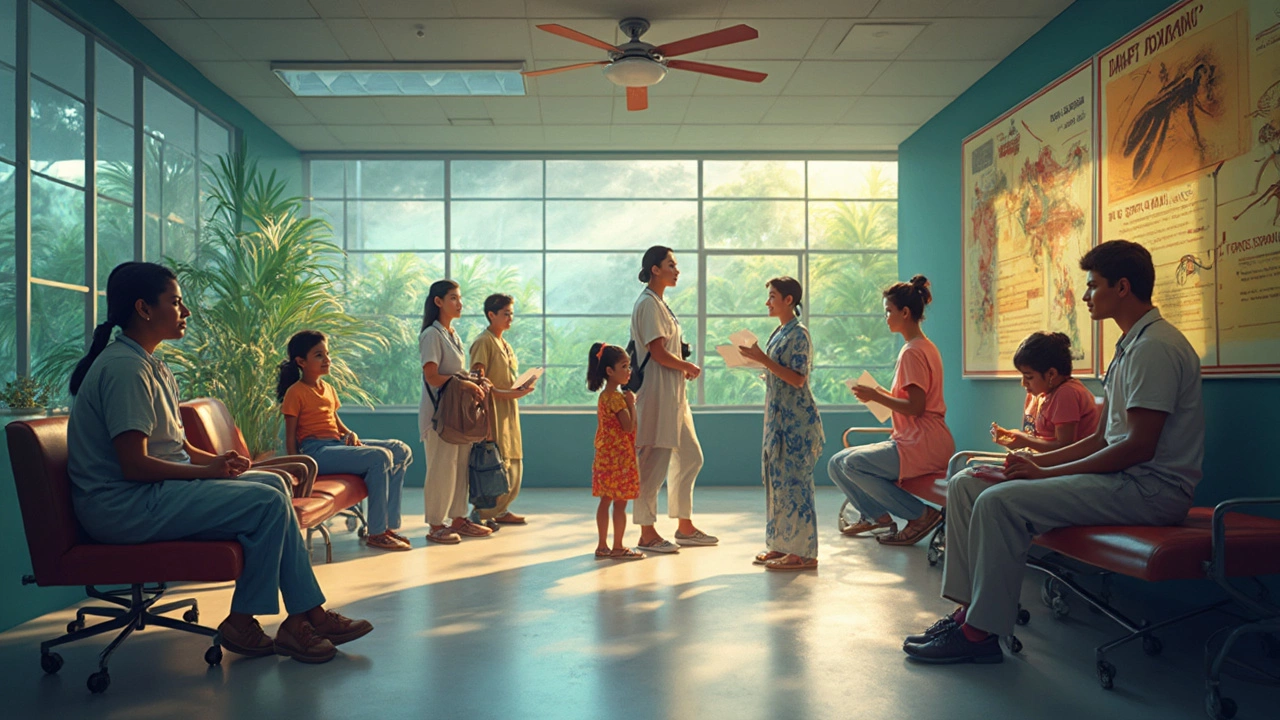Ask around, and you’ll hear stories—‘Oh, Costa Rica is paradise! Beaches, rainforests, cheap medical care.’ But here’s what tourists don’t expect: dengue fever is everywhere, especially during the rainy season. It’s not just a problem for locals; travelers can catch it just as easily. Dengue hits hard, with symptoms like fever, body aches, and sometimes a rash. Some people think it’s just a ‘bad flu,’ but it can ruin your trip or even land you in the hospital.
If you’re planning on coming to Costa Rica for dental work, surgery, or just a wellness retreat, you need to know what you’re up against. Hospitals here are usually clean, and doctors are well-trained, but prevention is your best weapon. Packing bug spray isn’t just a good idea—it’s essential. Know where you’re staying, check if they use mosquito screens, and look for accommodation with air conditioning to keep the bugs out.
Getting sick in a foreign country is no joke. Insurance might not cover everything, and a simple fever can turn into days lost in bed. We’ll walk through what you really need to know, so you can focus on healing, relaxing, or whatever brought you here—without worrying about dengue knocking you off your feet.
- Costa Rica’s Top Health Risk: Dengue Fever
- Why Dengue Is Such a Big Deal
- Medical Tourism: What Visitors Should Expect
- Hospitals, Clinics, and Real Healthcare Experiences
- Staying Safe: Practical Tips Against Dengue
- Do’s and Don’ts for Healthy Travels
Costa Rica’s Top Health Risk: Dengue Fever
If you look at health concerns in Costa Rica, dengue fever easily takes the top spot. This mosquito-borne illness spikes every year, especially in the rainy season—usually from May to November. In 2024 alone, Costa Rica reported over 25,000 confirmed cases, way higher than most other countries in the region. Some towns near the coast get hit harder—think Jacó, Puntarenas, and Limón. It’s not just the rural villages getting slammed; city neighborhoods see outbreaks too.
Dengue is spread by the Aedes aegypti mosquito. It usually bites during the day, so you can’t just rely on sleep nets at night. Early symptoms feel like really bad flu—high fever, headaches, eye pain, joint and muscle aches, and sometimes a rash. For some, it gets worse, leading to severe dengue, which can cause bleeding, serious drops in blood pressure, and even become life-threatening. Kids and people with other health issues are especially at risk.
Here’s what puts health problems Costa Rica in the spotlight for travelers:
- There’s no vaccine protection for most travelers; the old rule was "Don't get bitten."
- The mosquito breeds easily in any standing water—puddles, buckets, even flowerpots.
- Rainy months mean more mosquitos, and more mosquitos mean a higher risk for everyone.
Just to give you a real sense of the numbers, here’s what recent dengue stats looked like:
| Year | Reported Cases in Costa Rica |
|---|---|
| 2022 | 13,589 |
| 2023 | 21,234 |
| 2024 | 25,105 |
Dengue isn’t just a distant news story here—it’s the top health risk you’ll face as a medical tourist. If you plan ahead and take simple steps—like using repellents and avoiding standing water—you cut your odds of getting sick in a big way. No need to panic, but being smart about it will help you enjoy the best of Costa Rica without trouble.
Why Dengue Is Such a Big Deal
Most people don’t realize how common dengue fever really is in Costa Rica. In fact, in 2023 alone, Costa Rica recorded nearly 18,500 dengue cases according to the Ministry of Health. Outbreaks happen every year, most often between May and November, which is the rainy season. The humidity and standing water create ideal breeding grounds for mosquitoes that spread dengue.
Here’s the thing: there’s no vaccine to protect adults, and there’s no quick cure. If you come down with dengue, what you’re facing is a week—sometimes more—of high fevers, severe joint pain, headaches, and pure exhaustion. For some unlucky folks, it turns dangerous and can cause bleeding, which means a hospital stay. Dengue isn’t just uncomfortable. It can totally wreck your trip or medical procedure.
If you’re traveling for medical tourism, dengue adds risk you might not have planned for. Imagine you’re coming for surgery and you catch dengue right before or after. Recovery gets complicated and you’re dealing with extra bills, too. Tourists are just as likely to get dengue as locals since the mosquitoes don’t care where you’re from.
Breakdown of recent dengue cases by year:
| Year | Dengue Cases Reported |
|---|---|
| 2021 | 8,900 |
| 2022 | 12,700 |
| 2023 | 18,500 |
Worth noting, some of the riskiest areas include Puntarenas, Limon, and the Central Pacific. These spots are super popular with both surfers and folks seeking dental and cosmetic procedures.
- Dengue mosquitoes (Aedes aegypti) bite most often during the day, not at night.
- The mosquitoes can breed in tiny water pools—think bottle caps, not just ponds!
- Symptoms usually appear 4-10 days after a bite, so you might not realize you’re sick until you’re back at your hotel post-surgery.
So, this is why dengue isn’t just a minor hassle—it’s a real risk that can change your whole medical trip. A little awareness goes a long way to avoiding a lot of trouble.
Medical Tourism: What Visitors Should Expect
If you’re heading to Costa Rica for medical tourism, you’ll notice right away that hospitals and private clinics often look just as modern as what you're used to back home. Many doctors studied in the US or Europe, and most speak English pretty well. Dental work, cosmetic surgery, and joint replacements are big business here. The prices? You could pay 30% to 70% less than what you’d shell out in the States.
But here’s the part people don’t always talk about: Costa Rica’s health problems can surprise visitors who only plan for their procedures. Dengue fever can land anyone in the hospital—locals and tourists get it every year. In 2024 alone, there were over 70,000 reported dengue cases, which is the highest number in the past decade. Mosquito season runs May to November, and outbreaks jump during this time. Packing anti-mosquito gear is just as key as bringing your medical records.
| Service | Average Savings vs. US | Common Risks |
|---|---|---|
| Dental Implants | Up to 70% | Dengue, infections |
| Cosmetic Surgery | 50-60% | Anesthesia risks, dengue |
| Orthopedic Surgery | 40-60% | Blood clots, dengue |
Here’s what you should expect from the process:
- Consultations are friendly and often longer than you’d get in the US. Doctors actually take time to answer your questions.
- Paperwork is simple, but always double-check the details. Insurance coverage can vary.
- Hospitals and clinics are usually clean, but always check reviews and accreditations online before booking.
- Aftercare can be good, but you need to plan for post-surgery rest—don’t expect to hit the beach the day after your procedure.
- During dengue season, ask for rooms with AC and mosquito screens. It’s worth it.
Local medical staff will warn you that outdoor excursions right after a procedure raise your risk for infections and dengue. Don’t ignore them. As Dr. Alberto Morales, a leading infectious disease specialist in San José, puts it:
"Most tourists focus on surgery risks, but in our clinics, we see more complications from mosquito-related diseases than from the operations themselves.”
Bottom line: the system here works well if you do a little homework and take those dengue warnings seriously. Don’t gamble with your recovery—stay indoors, follow doctor instructions, and protect yourself from bites.

Hospitals, Clinics, and Real Healthcare Experiences
Let’s get straight to it—Costa Rica’s got a reputation for good, affordable care, which is one reason people fly in for medical tourism. Whether you land in San José or pop into a beach town, you’ll find both public and private hospitals. Public hospitals like Hospital México (San José) or Hospital San Juan de Dios handle emergencies, and they’re busy but staffed by real pros. Private hospitals, such as CIMA or Clínica Bíblica, look like something out of the U.S.—modern, clean, and loaded with English-speaking doctors.
Private care is faster, but it comes with a bill. Most tourists say you’ll get an appointment within a day or two. If you’re here for surgery or dental work, you’ll meet doctors trained in the States or Europe. A 2024 review found that 72% of foreign patients in Costa Rica rated their care as "excellent."
Here’s a quick look at what you might find and pay:
| Facility | Type | Avg. Cost (USD) | Wait Time |
|---|---|---|---|
| Hospital CIMA (Private) | Hospital | $70-100 (doctor visit) | Same day |
| Hospital México (Public) | Hospital | Free/low for residents | Several hours |
| Clínica Bíblica | Clinic/Hospital | $90-120 (doctor visit) | 1-2 days |
The vibe? People here are used to seeing medical travelers. Staff at most private hospitals speak English and will walk you through everything—no guesswork. Here’s what a real patient had to say:
“I got treated at CIMA after a bad fall. It was fast, cleaner than I expected, and the staff explained everything in English. My insurance from home worked too.” — Mark S., visitor from the US
Now, the public system (Caja) handles everyone, but if you don’t speak Spanish you might hit some snags. You’ll wait longer, and you might run into bureaucracy. For urgent dengue treatment, most tourists stick with private hospitals since you get quicker blood tests and checkups.
- Always ask for itemized bills at private clinics.
- Bring your passport—it’s needed for both private and public care.
- If you’re traveling to rural areas, know that clinics may not have all the latest equipment; serious cases get sent to the cities.
The bottom line: Costa Rica’s healthcare is easy to access if you know the system. Private care offers speed and comfort, but always keep travel insurance up to date so you’re not surprised by costs.
Staying Safe: Practical Tips Against Dengue
Dengue fever isn’t picky. Locals and travelers are all targets, especially during Costa Rica’s wet season (May to November). In 2024, public health data showed over 20,000 cases in just one year, proving it’s not something you can ignore. If you’re headed here for health problems Costa Rica or medical tourism, being cautious is just smart.
The trick is to avoid mosquito bites. These critters bite day and night, so you can’t just worry once the sun goes down. Take these practical steps:
- Use repellent with DEET. Don’t skimp. Reapply after sweating or swimming.
- Wear long sleeves and pants when possible. Loose clothes work better because mosquitoes can bite through tight fabric.
- Sleep in air-conditioned rooms, or if that’s not possible, always use a mosquito net—even one treated with insecticide is better.
- Make sure your room has window screens with no holes.
- Dump out any standing water near your room, even if it looks clean. Mosquitoes breed in the smallest puddles—buckets, vases, even bottle caps.
- If you’re staying long-term, ask around and use local mosquito foggers or sprays every few days.
If you want to see how risk changes over the year, here’s a quick look at reported dengue cases by month from Costa Rica’s Ministry of Health:
| Month | Reported Cases (2024) |
|---|---|
| January | 830 |
| February | 1,100 |
| March | 1,350 |
| April | 2,000 |
| May | 3,600 |
| June | 3,900 |
Notice how cases spike as the rain hits—that's when mosquitoes go wild. Don’t get lazy about prevention later in your trip; it only takes one bite to catch dengue.
If you feel sick (think high fever, bone pain, rash, or bad headaches), see a doctor fast. Early help can stop serious problems. Locals say, “It’s better to be paranoid than stuck in a clinic.” Believe them—the hassle of carrying repellent and checking rooms beats days of feeling miserable.
Do’s and Don’ts for Healthy Travels
If you don’t want your trip to Costa Rica sidelined by a mosquito bite or a surprise hospital visit, you’ve got to be smart about your choices. Here’s what you absolutely should—and should not—do if you want to dodge the most common health problems in Costa Rica and enjoy your visit.
- Do pack (and actually use) mosquito repellent with at least 20% DEET or picaridin. Mosquitoes carrying dengue are most active during the day, not at night.
- Do wear light-colored, long-sleeved shirts and pants, especially in early morning and late afternoon. Dengue mosquitoes love biting ankles and elbows.
- Do choose accommodations with screens on windows and doors, or with AC that lets you keep everything shut tight.
- Do keep an eye on your symptoms if you feel sick—fever, headache, muscle pain, or rash can all show up with dengue. Get checked by a local doctor if you’re not sure.
- Do get travel insurance that covers medical care in Costa Rica, including hospital stays and emergency evacuation. Public hospitals provide good care, but private clinics are popular with foreigners—and pricier.
- Don’t assume that resorts or fancy hospitals are mosquito-proof. Always check your room for open windows or gaps.
- Don’t leave water standing around your room or balcony—those tiny puddles are mosquito breeding grounds.
- Don’t ignore local updates on dengue outbreaks, especially in the rainy season (May–November). Ask your hotel staff for the latest info.
- Don’t wait to see if you “just get better” after a fever. Delaying treatment makes things worse.
- Don’t forget basic hygiene—always wash your hands or use sanitizer, especially before eating. Stomach bugs are less famous than dengue but way too common with travelers.
Here’s a quick look at where dengue cases usually pop up in Costa Rica. If you’re headed to any of these popular spots, stay alert:
| Region | Recent Dengue Cases (2024) |
|---|---|
| Puntarenas (Pacific beaches) | 3,200 |
| Limón (Caribbean coast) | 2,700 |
| San José (Central Valley, capital) | 1,800 |
| Guanacaste | 1,100 |
If you’re smart about it, Costa Rica really is a great place for medical tourism—just don’t gamble with your health. Follow these tips, and you’re way more likely to bring back memories, not a fever.





